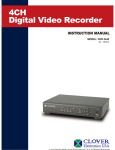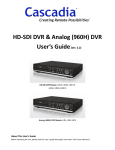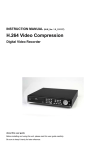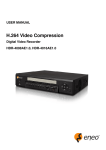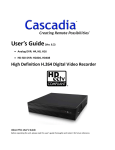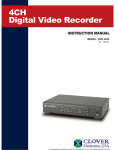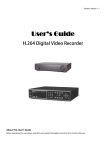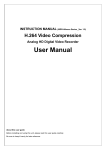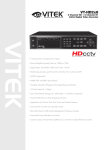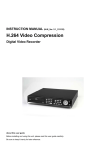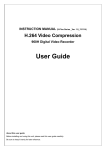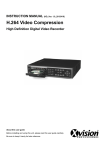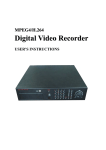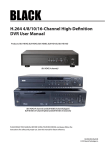Download HD-DVR user manual - ChipER technology
Transcript
(Ver. 3.0) H.264 Video Compression Stand Alone HD Digital Video Recorder User Guide About This User’s Guide Before operating the unit, please read this user’s guide thoroughly and retain it for future reference. ChipER Technology Corp. page 1 Cautions Explanation of Graphical Symbols This symbol indicates the presence of important operating and maintenance (servicing) instructions in the literature accompanying the product. This symbol indicates the presence of “dangerous voltage” within the product’s enclosure that may be of sufficient magnitude to constitute a risk of electric . shock, property damage, personal injury, or death. WARNING To reduce a risk of fire or electric shock, do not expose this product to rain or moisture. CAUTION Changes or modifications not approved by the manufacture will void the warranty of the product. Using an incompatible battery may increase the risk of fire or explosion. Replace only with the same or equivalent type battery recommended by the manufacture. Discard used batteries according to manufacturer’s instructions. ChipER Technology Corp. page 2 These precautions must be followed for safety reasons. Warning Do not use if the unit emits smoke. Do not disassemble the unit. Do not place any heavy or sharp objects on the unit. Do not place on uneven surface. Do not expose to shock or vibration. Do not move the unit when the unit is powered on. Do not block, and allow dust to accumulate in the air vents. Do not restrict airflow of the unit; doing so can damage the unit. Installation and servicing should be performed only by qualified and experienced personnel. Turn off the power of the DVR when connecting Cameras, Audio or Sensor Cables. The manufacture is not responsible for any damage caused by improper use of the product or failure to follow instructions for the product. The manufacture is not responsible for any problems caused by or resulting from the user physically opening the DVR for examination or attempting to repair the unit. The manufacture may not be held liable for any issues with the unit if the warranty seal is removed. ChipER Technology Corp. page 3 Table of Contents Product Components ........................................................................................................ 7 Features............................................................................................................................. 8 Specifications: SDR-SDR550-04, SDR550-08, SDR550-16…………………………..….… 11 1. Name, Function and Connection .................................................................................. 13 1-1. Front Panel................................................................................................................. 13 1-2. Rear Panel ................................................................................................................. 15 1-3. Remote Control ........................................................................................................... 17 2. Preparation .................................................................................................................. 18 2-1. DVD-RW Installation .................................................................................................. 18 2-2. Hard Drive Installation ................................................................................................ 19 2-3. Compatible HDD Models ............................................................................................ 20 2-4. Setting Daylight Saving Time ..................................................................................... 22 2-5. Setting NTP (Network Time Protocol)........................................................................ 23 3. 26 Setting up the DVR ..................................................................................................... 3-1. Setup – Main screen and Menu Tree ......................................................................... .26 3-2. Setup – Display Mode ................................................................................................ 30 3-3. Setup – Record Mode ................................................................................................ 31 3-3-1. Recording Schedules .............................................................................................. 34 3-4. Setup – Device Mode ................................................................................................. 35 3-4-1. ALARM-OUT ........................................................................................................... 36 3-4-2 SPOT-OUT Setup ................................................................................................... 36 3-4-3 CONTROLLER & PTZ Setup .................................................................................. 37 3-4-4. Motion Zone Setup ................................................................................................. 38 3-5. Setup – Storage Mode............................................................................................... 39 3-6. Setup – System Mode ............................................................................................... 40 3-7. Setup – Security Mode .............................................................................................. 41 3-8. Setup – Network Mode .............................................................................................. 45 3-8-1. DDNS ..................................................................................................................... 46 3-8-2. Network Ports......................................................................................................... 47 3-8-3. Network Stream....................................................................................................... 48 ChipER Technology Corp. page 4 3-9. Setup - CONFIG Mode ............................................................................................... 49 3-10. Quick Setup.............................................................................................................. 4. 50 Live, Search and Playback ......................................................................................... 51 4-1. Live Viewing Screen ................................................................................................... 51 4-2. SEARCH Screen ........................................................................................................ 53 4-2-1. TIME-LINE Search .................................................................................................. 54 4-2-2. Event Search........................................................................................................... 55 4-2-3. Go To First Time ...................................................................................................... 55 4-2-4. Go To Last Time ...................................................................................................... 55 4-2-5. Go To Specific Time ................................................................................................ 56 4-2-6. Archive Search ........................................................................................................ 56 4-2-7. Log Search.............................................................................................................. 57 4-3. Play Mode .................................................................................................................. 58 5. PTZ Control ................................................................................................................ 59 6. Back Up ...................................................................................................................... 60 6-1. Still Image Backup onto USB Flash Drive .................................................................. 60 6-2. Video Backup onto USB Flash Drive .......................................................................... 60 6-3. Transferring Still Images or Video from the ARCHIVE List ......................................... 61 6-4. Playback of Backup Video.......................................................................................... 7. 62 Network Access Using the Single Site Network Viewer ............................................... 63 7-1. PC Requirements ........................................................................................................ 64 7-2. Installing the Network Viewer ...................................................................................... 64 7-3. Live Monitoring Mode and Functions........................................................................... 65 7-4. Bi-directional Audio...................................................................................................... 67 7-5. Remote Search Mode and Functions .......................................................................... 67 7-6. PC System Configuration ................................................... ........................................ 69 8. Network Access Using the Multi-Sites Network Viewer................................................ 74 8-1. Overview ..................................................................................................................... 74 8-2. Minimum PC Requirements ........................................................................................ 74 8-3. Installation of the Program .......................................................................................... 74 8-4. Live Window ................................................................................................................ 76 8-4-1. Main User Interface .................................................................................................. 78 8-4-2. Control Buttons ........................................................................................................ 78 8-5. Search and Playback Window..................................................................................... 78 8-5-1. Main User Interface .................................................................................................. 78 8-5-2. Main Control Panel................................................................................................... 79 ChipER Technology Corp. page 5 8-6. Setup of UMS Multi Client ........................................................................................... 81 8-6-1. General .................................................................................................................... 81 8-6-2. Event ........................................................................................................................ 81 8-6-3. Record ..................................................................................................................... 81 8-6-4. OSD ......................................................................................................................... 81 8-6-5. Language ................................................................................................................. 85 8-7. Remote Setup ............................................................................................................ 86 8-7-1. Setting the Display .................................................................................................. 86 8-7-2. Record .................................................................................................................... 86 8-7-3. Storage.................................................................................................................... 87 8-7-4. Device ..................................................................................................................... 87 8-7-5.Upgrade ................................................................................................................... 87 8-7-6. System ................................................................................................................... 88 8-7-7.Network .................................................................................................................... 88 8-8. Operation ................................................................................................................... 89 8-8-1. Addition, Delete, and Modify of DVR Sites .............................................................. 90 8-8-2. Connect and Disconnect ......................................................................................... 91 8-8-4. Recording Video on Local PC during Live .............................................................. 93 8-8-5. Local Playback and Remote Playback ................................................................... 96 9-8-6. AVI Backup During Playback .................................................................................. 97 9. Network – By a Web-Browser Viewer ......................................................................... 99 10. Network Access Using the Mobile Viewer .............. .................................................. 102 10-1. Installing the Viewer ................................................................................................. 102 10-2. iUMS for Android Live Monitoring and PTZ Control .................................................. 102 10-2-1. Live ........................................................................................................................ 102 10-2-2.PTZ Control............................................................................................................. 102 10-3. iUMS for Apple iPhone .............................................................................................. 103 10-3-1. Live ........................................................................................................................ 103 10-3-2.PTZ Control............................................................................................................. 103 10-3-3. Playback ................................................................................................................ 103 APPENDIX: How to Connect the Network ......................................................................... 106 A. How to set the IP address of the DVR and open TCP port of the router? .................... 106 B. How to access DVR from a Remote PC? .................................................................... 109 LAN Connection – Using a Switching Hub……................................................................ 109 Internet Connection Using DDNS ...................................................................................... 111 ChipER Technology Corp. page 6 Product Components Please make sure the following components are included as specified below. DVR Unit Client Software CD Remote Control Battery1.5V (AAA x 2EA) User Guide (as PDF on Client Software CD) Data Power Cable (x2 EA) Mounting Bracket & Screws (x2 EA) HDD Mounting Screws Power Adaptor (DC12V 5A ) & Power Cable (110V or 220V) ChipER Technology Corp. page 7 Features H.264 V ideo compression HDcctv/HD-SDI Compatible HDMI 1080P V ideo Output Reliable File System 4 Channel Audio Recording: Perfect audio sync. for court evidence. Bi-directional Audio over network via Network Client Software, Web-Viewer, CMS, and Mobile Viewer Individual Channel Operation Motion Detection ChipER Technology Corp. page 8 Easy and Simple Graphic User Interface Simple Scheduler Easy Software Upgrade via USB flash drive or Network software. Instant and Convenient Backup via USB Flash Drive, Network or DVD-RW ChipER Technology Corp. page 9 Exclusive File Format and AVI Backup Time stamp over AVI backup data for court evidence S.M.A.R.T. (Self-Monitoring, Analysis, and Reporting Technology for HDD) Automatic Video Input and Video Loss Detection Covert Camera Operation (Provides Enhanced Security) Built-in PTZ Camera Control Variety of Ways Network Access via Network Client Software, Web-Viewer, CMS, and Mobile Viewer ChipER Technology Corp. page 10 Specifications:SDI-SDR550-04, SDI-SDR550-08, SDI-SDR550-16 ITEM Recording Performance Channel Input SDR550-04 SDR550-08 SDR550-16 720p x 48FPS/ 720p x 120FPS/ 1080P X 40FPS 720p x 192FPS/ 1080P X 80FPS 4 Channels 8 Channels 16 Channels Input Level Video HDcctv/HD-SDI VGA Output VGA (Max. 1080p) HDMI 1 HDMI (Max. 1080p) HD-SDI Audio Alarm Operation 1 Channel 4 Line input & 1 Line output Input & Output Audio Codec G.711 (ADPCM) Sensor Input 4/8/16CH, NC/NO Selectable Alarm Out 1/2/4CH out by Sensor, Motion and Video Loss Multi-operation QuadPlex: Playback/Record/Backup/Network Playback H.264 1280 x1080 48fps 96fps 192fps Full HD 1920 x1080 Recoding Quality Grade 20fps 40fps 5 Grades 80fps HD Display Recording Mode Continuous, Schedule, Motion, Sensor, Manual Motion Detection Setup by Grid Pre Recording Min. 15 seconds and Max. 20 minutes Post Recording Min. 10 seconds and Max. 60 minutes Multi-Decoding 1,4 1,4,8 1,4,8,4,16 Playback speed X1/4~x32 X1/4~x16 X1/4~x8 File Format Media Web viewer (1:1) 3G Mobile Viewer (1:1) Multi-sites Monitoring SW (1:n) Interface Storage HDD Timeline, Event, Archive, Log, Specific Time JPEG/Proprietary Format USB/External HDD/DVD/Network Built-in Viewer Network Real Time Frame Rate Search Mode Backup 4 Line input & 1 Line output 1CH Line and HDMI Output Compression Recording 8 Line input & 1 Line output Capacity of 1 HDD Internal HDD Number ChipER Technology Corp. Yes Live, Search, Backup, PTZF, Remote Setup, Remote Upgrade, Two Way Audio Live, Search, Backup, PTZF, Two Way Audio (Live, Search, Backup, PTZF, Remote Setup, Remote Upgrade, Two Way Audio SATA, e-SATA 2TB 1EA (2EA without DVD-RW), 2EA (4EA without DVD-RW) page 11 ITEM User Interface SDR550-04 SDR550-08 SDR550-16 Menu Display Graphic User Interface Input Method Front Buttons, IR Remote control, Mouse, Keyboard controller 1 RS-232C POS Serial PTZ & Controller Network Network Access Ethernet 2 RS-485 RJ-45, 10/100/1000Base-T, Auto MDI/MDIX Web Viewer Live, Search/Playback, Backup, PTZF, Remote Setup/Upgrade Single-site monitoring software Live, Search/Playback, Backup, PTZF, Remote Setup/Upgrade Multi-sites monitoring software Live, Search/Playback, Backup, PTZF, Remote Setup/Upgrade DST (Daylight Saving Time) Internal Beep Multi Language Features 1 RS-485 Software Upgrade Yes By Alarm, Motion, Video Loss, HDD error Yes (more than 20 languages) By USB, Network Remote Upgrade NTP Yes Watermarking Yes 3G Mobile Operation Condition Power iPhone, Android, Blackberry 5°C - 40°C, During storage: -10°C - +50°C DC 12V 5A General Net Weight (Gross Weight) Unit Dimension (W x D x H) AC100~120V/200~240V, 50/60Hz, 280W 9 Lbs. (13.6 Lbs.) / 15 Lbs. (19.8 Lbs.) 14.96” x 13.38”mm x 2.83”mm 17.00” x 16.92”mm x 3.86”mm Please note that specifications and unit exterior design are subject to change without notification. ChipER Technology Corp. page 12 1. Name, Function and Connection 1-1. Front Panel The following information will help you to operate the front panel controls. NO Name Description Channel keys. For channel 10, press the 0 key. For 1 channel 11, press the +10 and 1 key. For channel 16, press the +10 and 6 key. 2 In playback mode, press to rewind the recording. 3 Press to select an audio mode: MUTE –Mute all 4 channels. SINGLE- Highlighted channel only. MIX- Mix all 4 channels 4 Jump/step backward. In playback mode, the playback position moves 60 seconds backward. 5 In playback mode, press to fast forward the recording. 6 Press to enable/disable ALARM operation. 7 Jump/step forward. In playback mode, the playback position moves 60 seconds forward. 8 Press to start or stop manual recording. ChipER Technology Corp. page 13 NO Name 9 Description In live display mode, press to open the SEARCH menu. 10 In playback mode, press to play/pause the footage. 11 Press to open the SETUP menu. 12 Enable/disable the automatic sequence of display of channels 13 in full screen, quad, 9-split display mode. Press to control Pan/T ilt/Zoom operations. 14 Press to capture video in jpeg format in live or playback mode. Press to move left or to change the values in Setup mode. It is also used as the number 4 when entering password. 15 (LEFT) 16 (UP) Press to move up the menu in Setup mode. It is also used as the number 1 when entering password. 17 (RIGHT) Press to move right or to change the values in Setup mode. It is also used as the number 2 when entering password. 18 (DOWN) Press to move down the menu in Setup mode. It is also used as the number 3 when entering password. 19 Press to select desired menu item or to store the setup value. 20 Press for temporary storage of the changed value or to return to the previous menu screen. 21 USB Port 22 OPEN/CLOSE 23 DVD Drive ChipER Technology Corp. To archive still-image or video into a USB flash drive or upgrade the firmware with USB flash drive. To open and close the insert tray, press the button. To save video, insert a CD-R/DVD-R. page 14 NO Name Description A CH1~16 Indicates that the channel is being recorded. B HDD Indicates that the system is accessing the hard disk. C ALARM Indicates that sensor(s) is/are triggered or motion is detected. D NETWORK Indicates that a network client is connected E BACKUP Indicates that a USB or DVD-RW device contains stored data F POWER Indicating that the system is powered on. 1-2. Rear Panel 1-2-1. SDI-SDR550-04 1 Cooling Fan 2 HD-SDI Video Input 3 Audio Input 4 HDMI Video Output 5 RS 232 Terminal (For testing purposes) 6 VGA Output 7 eSATA Port 8 Network RS-45 Ethernet Port 9 USB Port 10 RS-485 PTZ Camera control terminal 11 DC12V Power Input ChipER Technology Corp. page 15 1-2-2. SDI-SDR550-008 1 2 3 4 5 6 7 8 9 10 11 HD-SDI Video Input Audio Input RS 232 Terminal (For testing purposes) VGA Output HDMI Video Output RS 232 Terminal (For testing purposes) USB Port RS-485 PTZ Camera control terminal RS-485 Termination Network RS-45 Ethernet Port eSATA Port RS-485 DC12V Power Input 1-2-3. SDI-SDR550-016 1 2 3 4 5 6 7 8 9 10 11 12 13 HD-SDI Video Input Video output Audio Input RS 232 Terminal (For testing purposes) VGA Output HDMI Video Output USB Port RS-485 PTZ Camera control terminal Network RS-45 Ethernet Port eSATA Port RS-485 Termination Sensor in Terminal DC12V Power Input ____________________________________________________ ChipER Technology Corp. page 16 1-3. Remote Control ① ID: When a remote control ID number is set in the DVR, input the DVR ID number. ② REC: To start and stop manual recording. ③ Number: To select channel (1, 2, 3, & 4) or to enter DVR ID number. ④ F/REW: During playback - To move the playback position 60 seconds backward. During pause - To move the playback position 1 frame backward. ⑤ F/ADV: During playback - To move the playback position 60 seconds forward. During pause - To move the playback position moves 1 frame forward. ⑥ REW: To rewind the footage at 1x, 2x, and 4x speed during playback. ⑦ PLAY/PAUSE: To play or to pause the footage in playback mode. ⑧ FF: To fast forward the footage at 1x, 2x, and 4x speeds during playback. ⑨ Control button: Press to move the menu items or select channel. ⑩ SETUP: To launch SETUP menu. ⑪ SEARCH: To go to the search menu. ⑫ ESC: During setting - To return to previous menu screen. During playback - To exit from playback System Lock – To lock a system when pressing ESC button for 5 seconds. System Unlock – To unlock a system when pressing ESC button for 5 seconds. ⑬ BACKUP: To start operations of backup in live or playback mode. (The same function button as CAPTURE on thefront panel of DVR) ⑭ SEQ: To start auto sequencing of the screen in full screen mode. (Toggle) ChipER Technology Corp. page 17 2. Preparation 2-1. DVD-RW Installation 1. Remove the screws and the top cover as specified below. 3. 2. Install the DVD-RW mounting bracket to the DVD-RW by using the mounting bracket screws as specified below. Connect the DVD-RW Data Power Cable to both the DVD-RW and main board. ChipER Technology Corp. page 18 2-2. Hard Drive Installation 1. Before HDD. installing bracket and screws onto the 2. Install the mounting bracket on the HDD. 3. Installation HDD and Bracket onto base case (Inside) 4. Installation HDD and Bracket onto base case (Outside) 5. Connect the Data Power cable to the HDD. 6. ChipER Technology Corp. Installed HDD and DVD-RW. page 19 2-3. Compatible HDD Models Manufacturer Model ChipER Technology Corp. BUFFER 2 TB 7200 RPM 64 MB ST31000526SV(Surveillance) 1 TB 7200 RPM 32 MB ST31000524AS(Barracuda) 1 TB 7200 RPM 32 MB ST31000340SV(Surveillance) 1 TB 7200 RPM 32 MB 1 TB 7200 RPM 32 MB 1 TB 7200 RPM 32 MB ST31000322CS 1 TB 5900 RPM 8 MB ST31000524AS 1 TB 7200 RPM 32 MB ST3500411SV(Surveillance) 500 GB 7200 RPM 16 MB ST3500413AS(Barracuda) 500 GB 7200 RPM 16 MB 500 GB 7200 RPM 8 MB ST31000528AS(Barracuda) HITACHI RPM ST32000641AS(Barracuda XT) ST31000526SV Seagate Capacity ST3500830SCE ST3500418AS(Barracuda) 500 GB 7200 RPM 16 MB ST3500410AS(Barracuda) 500 GB 7200 RPM 16 MB ST3500312CS 500 GB 5900 RPM 8 MB ST500DM002 500 GB 7200 RPM 16 MB ST3250410AS(Barracuda) 250 GB 7200 RPM 16 MB ST3250310SV(Surveillance) 250 GB 7200 RPM 8 MB ST3250318AS(Barracuda) 250 GB 7200 RPM 8 MB ST3250312CS 250 GB 5900 RPM 8 MB ST3500312CS 250 GB 5900 RPM 8 MB ST3160815AS(Barracuda) 160 GB 7200 RPM 8 MB HDS723020BLA642 2 TB 7200 RPM 64 MB HDS722020ALA330 2 TB 7200 RPM 32 MB HDS721010KLA330 1 TB 7200 RPM 32 MB HDT721010SLA360 1 TB 7200 RPM 16 MB HDS721010CLA332 1 TB 7200 RPM 32 MB HDS721050CLA362 500 GB 7200 RPM 16 MB HDP725050GLA360 HDS721032CLA362 500 GB 320 7200 RPM 16 MB HDS721025CLA382 250 GB 7200 RPM 8 MB HDT721025SLA380 250 GB 7200 RPM 8 MB HDP725025GLA380 250 GB 7200 RPM 8 MB page 20 Manufacturer Western Digital Model Capacity RPM BUFFER WD20EADS 2 TB 7200 RPM 32 MB WD20EURS 2 TB 7200 RPM 64 MB WD10EVVS 1 TB 7200 RPM 8 MB WD10EACS 1 TB 7200 RPM 16 MB WD10EURS-630AB1 1 TB 7200 RPM 64 MB WD10EALX-009BA0 1 TB 7200 RPM 32 MB WD5000AACS 500 GB 7200 RPM 16 MB WD5000AAKX-001CA0 500 GB 7200 RPM 16 MB WD2500AAKX 250 GB 7200 RPM 16 MB WD2500AVVS 250 GB 7200 RPM 8 MB WD2500AAKX-001CA0 250 GB 7200 RPM 16 MB WD2500AAKS 250 GB 7200 RPM 16 MB NOTICE: The brands and models of all HDD should be the same. If the brands and models of the HDD are different, the DVR may not recognize HDD or malfunction. ChipER Technology Corp. page 21 2-4. Setting Daylight Saving Time If the DVR is to be set Day Light Saving T ime and be synchronized NTP (Network Time Protocol), Take next steps. 1. Click a mouse-right button or SETUP button on the front panel of DVR to enter the SETUP mode. The default Password is “1111”. 2. Go to SETUP>SYSTEM>SET DATE & TIME 3. Select DAYLIGHT SAVING. ChipER Technology Corp. page 22 2-5. Setting NTP (Network Time Protocol) 1. When the DVR is connected with internet and the DVR need to be synchronized with NTP (Network Time Protocol), set SETUP>SYSTEM>NTP ON. 2. Select proper TIME ZONE time. Pacific Time Zone Los Angles, CA, USA : GMT - 8:00 for Standard time / GMT - 7:00 for Daylight time Mountain Time Zone Denver, CO, USA : GMT - 6:00 for Standard time / GMT - 5:00 for Daylight time Central Time Zone Chicago, IL, USA : GMT - 7:00 for Standard time / GMT - 6:00 for Daylight time Eastern Time Zone New York, NY, USA : GMT - 5:00 for Standard time / GMT - 4:00 for Daylight time State Standard Time Daylight-Saving Time AL Alabama GMT-6 GMT-5 AK Alaska GMT-9 GMT-8 AK Alaska (Aleutian Islands) GMT-10 NA AZ Arizona GMT-7 NA ChipER Technology Corp. page 23 State Standard Time Daylight-Saving Time AZ Arizona (Navajo) GMT-7 GMT-6 AR Arkansas GMT-6 GMT-5 CA California GMT-8 GMT-7 CO Colorado GMT-7 GMT-6 CT Connecticut GMT-5 GMT-4 DC District of Columbia GMT-5 GMT-4 DE Delaware GMT-5 GMT-4 FL Florida GMT-5 GMT-4 FL Florida (W) GMT-6 GMT-5 GA Georgia GMT-5 GMT-4 HI Hawaii GMT-10 NA ID Idaho (N) GMT-8 GMT-7 ID Idaho (S) GMT-7 GMT-6 IL Illinois GMT-6 GMT-5 IN Indiana GMT-5 GMT-4 IN Indiana (SW / NW) GMT-6 GMT-5 IA Iowa GMT-6 GMT-5 KS Kansas GMT-6 GMT-5 KS Kansas (W) GMT-7 GMT-6 KY Kentucky (E) GMT-5 GMT-4 KY Kentucky (W) GMT-6 GMT-5 LA Louisiana GMT-6 GMT-5 ME Maine GMT-5 GMT-4 MD Maryland GMT-5 GMT-4 MA Massachusetts GMT-5 GMT-4 MI Michigan GMT-5 GMT-4 MI Michigan (W) GMT-6 GMT-5 MN Minnesota GMT-6 GMT-5 MS Mississippi GMT-6 GMT-5 MO Missouri GMT-6 GMT-5 MT Montana GMT-7 GMT-6 NE Nebraska GMT-6 GMT-5 NE Nebraska (W) GMT-7 GMT-6 NV Nevada GMT-8 GMT-7 NH New Hampshire GMT-5 GMT-4 NJ New Jersey GMT-5 GMT-4 ChipER Technology Corp. page 24 State Standard Time Daylight-Saving Time NM New Mexico GMT-7 GMT-6 NY New York GMT-5 GMT-4 NC North Carolina GMT-5 GMT-4 ND North Dakota GMT-6 GMT-5 ND North Dakota (W) GMT-7 GMT-6 OH Ohio GMT-5 GMT-4 OK Oklahoma GMT-6 GMT-5 OR Oregon GMT-8 GMT-7 OR Oregon (E) GMT-7 GMT-6 PA Pennsylvania GMT-5 GMT-4 RI Rhode Island GMT-5 GMT-4 SC South Carolina GMT-5 GMT-4 SD South Dakota (E) GMT-6 GMT-5 SD South Dakota (W) GMT-7 GMT-6 TN Tennessee (E) GMT-5 GMT-4 TN Tennessee (W) GMT-6 GMT-5 TX Texas GMT-6 GMT-5 TX Texas (W) GMT-7 GMT-6 UT Utah GMT-7 GMT-6 VT Vermont GMT-5 GMT-4 VA Virginia GMT-5 GMT-4 WA Washington GMT-8 GMT-7 WV West Virginia GMT-5 GMT-4 WI Wisconsin GMT-6 GMT-5 WY Wyoming GMT-7 GMT-6 NOTE: If you want the unit to automatically synchronize the local time, the Time Zone must be properly set according to your local Time Zone. ChipER Technology Corp. page 25 3. Setting up the DVR The following sections detail the initial setup of the DVR. 3-1. Setup – Main screen and Menu Tree To enter the setup menu, right click on the mouse and select setup from the submenu or press the setup button on the front panel or the remote control. Figure 3.1.1. Setup Menu Tree When the DVR prompts the LOG-IN window, enter the PASSWORD using the virtual keyboard, or the front panel, or the remote control. The factory default password is 1111. It is highly recommended to assign a new password to protect the system. User can assign a new password in SECURITY setup menu. ChipER Technology Corp. page 26 DISPLAY – OSD – OSD CONTRAST – SEQUENCE – SEQUENCE DWELL TIME – CHANNEL - COVERT - BRIGHTNESS - CONTRAST - HUE - SATURATION RECORD – NAME VIDEO OUTPUT - CHANNEL - RESOLUTION - FRAME RATE - QUALITY - RECORDING - SENSOR RECORDING - PRE RECORD - POST EVENT RECORD - AUDIO - SCHEDULE DEVICE ChipER Technology Corp. page 27 – – – – ALARM OUT - SENSOR IN - MOTION ON - VIDEO LOSS ON - ALARM DURATION - ERROR ALARM CONTROLLER & PTZ - CHANNEL - NAME - SPEED - ID SPOT OUT - SPOT OUT 1 - SPOT OUT 2 CHANNEL - MOTION ZONE - MOTION SENSITIVITY – KEY TONE – REMOTE CONTROLLER ID – SENSOR - TYPE STORAGE – OVERWRITE – DISK FORMAT – DISK INFO – RECORDING LIMIT – S.M.A.R.T SYSTEM – DVR-ID – DESCRIPTION – LANGUAGE – DATE FORMAT – SET DATE & TIME - DAYLIGHT SAVING - SET DATE & TIME – CLIENT ACCESS – NTP – SEND EMAIL SECURITY – – USER AUTHENTICATION (ADMIN, NETWORK, USER1, USER2, USER3) USER PASSOWRD ChipER Technology Corp. page 28 – PLAYBACK AUTHORITY NETWORK – PORT – NETWORK AUDIO PORT – WEB PORT – NETWORK TYPE (DHCP, LAN) – DDNS – NETWORK STREAM CONFIG – SAVE SETUP TO A USB – LOAD SETUP FROM A USB – LOAD DEFAULT – LOAD FACTORY DEFAULT – SOFTWARE UPGRADE QUICK SETUP – USE QUICK SETUP - – INPUT DESIRED DAYS CUSTOMER SETTINGS - RESOLUTION - FRAME RATE - QUALITY - RECORDING - DAYS TO RECORD ChipER Technology Corp. page 29 3-2. Setup – Display Mode In the SETUP menu, select the DISPLAY tab. Then, the DISPLAY menu is displayed as pictured below. Navigate through the menu items using the mouse or the control button (◀ ▲ ▶ ▼) on the remote control and change the value of the menu item. Figure 3.2.1. Display Mode Setup Screen Table 3.2.1. Menu Items in DISPLAY Mode Setup Item Description OSD Enable/disable on-screen-display. OSD CONTRAST Set the visibility level of the On Screen Display (OSD) (0~100) SEQUENCE Enable/disable sequential display of video in full screen mode. SEQ-DWELL TIME Set the dwell time of each, quad or 9 channels display in sequential display mode. (3-60seconds) Select a channel for applying the following settings using the mouse or control button on the remote control. Press the right square button to change the setting value of all channels at once. Press SEL button to change the setting CHANNEL value of all channels at once. Left click on the mouse to highlight the setting and double-click if you want to change the value. Once the value has been changed, select OK to confirm the changes. (COVERT, BRIGHTNESS,CONTRAST,HUE,SATURATION) ChipER Technology Corp. page 30 Set the channel name. Press the right square button and set the channel name and select OK using the mouse or the control button (◀ ▲ ▶ ▼) on the remote control. The name can be made by 10 characters at most. NAME COVERT Enable/disable display of the specified video channel in live display mode. BRIGHTNESS Change the brightness value of the specified channel. (0~100) CONTRAST Change the contrast value of the specified channel. (0~100) HUE Change the hue value of the specified channel. (0~100) SATURATION Change the saturation value of the specified channel. (0~100) VIDEO OUTPUT (HDMI/VGA) Allows user to set monitor output resolution from 720p 50Hz/60Hz, 1080i 50Hz/60Hz, 1080p 50Hz/60Hz ChipER Technology Corp. page 31 3-3. Setup – Record Mode In the SETUP menu, select the RECORD tab. Then, the RECORD menu is displayed as pictured below. Navigate through the menu items using the mouse or the control button on the remote control and change the value of the menu item. Figure 3.3.1. Recording Mode Setup Screen Table 3.3.1. Menu Items in Recording Mode Setup Menu Item Description CHANNEL Select a channel for applying the following settings using the mouse or the control button on the remote control. Press the right square button to change the setting value of all channels at once. Once you the value has been changed, select OK to confirm the changes. (RESOLUTION, FRAME RATE, QUALITY, RECORDING, PRE RECORD and POST EVENT RECORD) RESOLUTION Analog DVR (N-0440MH, N-0840MH, N-1640MH): Select either CIF, Half D1 and D1 using the mouse or the control button on the remote control. HD-SDI DVR (HD-0405M, HD-0810M): Select either 640 x 360, 1280 x 720, 1920 x 1080 using the mouse or the control button on the remote control. Set the frame rate for the specified channel. The sum of the frame rate values FRAME RATE from each channel cannot exceed the maximum frame rates for a specific recording resolution. Typical values of the maximum frame rate for video are as follows. ChipER Technology Corp. page 32 Analog DVR CIF Half D1 D1 N-0440MH 120fps/4CH 120fps/4CH 120fps/4CH N-0840MH 240fps/8CH 240fps/8CH 120fps/8CH N-1640MH 480fps/16CH 240fps/16CH 120fps/16CH HD-SDI DVR 640 x 360 1280 x 720 1920 x 1080 HD-0405M 120fps/4CH 48fps/4CH 20fps/4CH HD-0810M 240fps/8CH 96fps/8CH 40fps/8CH QUALITY Select the recording quality for the specified channel. LEVEL 1 ~ LEVEL 5 (Allows the user to change the recording QUALITY of the selected CHANNEL) RECORDING Assign the recording mode for each channel. Options are: Continuous, By Motion, By Sensor, By Schedule or Disable. PRE RECORD Enable/disable pre-event recording. Pre-event recording time is 5 seconds to 20 Minutes. POST EVENT RECORD Set the post event recording time duration for the specified channel. (10~60 seconds) SENSOR RECORDING Enable setting up to 4 sensors for the specified channel using the mouse or the control button of the remote control. AUDIO Enable/disable audio recording for the specified channel. SCHEDULE Set the recording schedule. Press SEL to enter the schedule setup screen. ChipER Technology Corp. page 33 3-3-1. Recording Schedules To setup a recording schedule, select SCHEDULE in the RECORD menu. Navigate through the menu items using the mouse or the control button on the remote control. [Channel]: Select the specific channel. [Setup]: Set up using the left button of the mouse to section under the specific day and time. It can set the all section under the specific day or time at a time when pressing the specific day or time. It is also possible to set up recording modes of various type using a CONTINUOUS (green), Motion (yellow) and Sensor (red). Left-Click and drag the mouse to change the schedule for more than one timeslot. [COPY Schedule]: To copy the schedule setup from one channel to another, select the channel to copy using the mouse or the buttons on the remote control, and select to channel to copy to and press the select button. Select OK to confirm the changes. Figure 3.3.2. Schedule Recording Setup Screen ChipER Technology Corp. page 34 3-4. Setup – Device Mode In the SETUP menu, select the DEVICE tab. Then, the device menu is displayed as pictured below. Navigate through the menu items using the mouse or the control button on the remote control and change the value of the menu item. Figure 3.4.1. Device Mode Setup Screen Table 3.4.1. Menu Items in Device Setup Screen Item Description ALARM OUT Set the sensor, motion, and video loss for each alarm. CONTROLLER & PTZ Set the PTZ baud rate, protocol, and ID. SPOT-OUT Set the all details for spot monitoring. It supports 2 spot-outs. CHANNEL Select specified channel for motion zone setup. MOTION ZONE Select either Full Zone or Partial Zone for motion sensing. MOTION SENSITIVITY Set the motion sensitivity for the specified channel. Control the motion sensitivity from 1 to 9. KEY TONE Enable/disable key tone. REMOTE CONTROL ID Select an ID of remote control. 1. Select ID number. 2. Press the same number as ID set in DVR on the remote control. 3. An icon will be displayed on the Live Screen that corresponds to the remote control ID number.0 The options are from 0 to 99 SENSOR Select sensor NO from 1 to 4 TYPE Set the type of sensor for the specified channel. Options are: OFF, N/O (normal open), and N/C (normal closed). ChipER Technology Corp. page 35 3-4-1. ALARM-OUT Figure 3.4.2. ALARM-OUT Setup Screen Table 3.4.2. Menu Item in ALARM-OUT Setup Screen Item Description ALARM OUT Select an Alarm out number. Available No: 4 CH (1) SENSOR IN Enable Alarm Out by Sensor up to 4 Inputs. MOTION ON Enable Alarm Out by Camera Motion up to 4 cameras. VIDEO LOSS ON Enable Alarm Out by Video Loss up to 4 cameras. ALARM DURATION Set the alarm dwell time from 5 to 60 seconds. ERROR ALARM Set the error type for the alarm activation. The options are OFF, ALL, HDD ERROR and VIDEO LOSS. 3-4-2 SPOT-OUT Setup Figure 3.4.3. SPOT-OUT Setup Screen Table 3.4.3. Menu item in SPOT-OUT Setup Screen Item Description SPOT ON EVENT Enable/Disable display of the channel when an event is active. SPOT EVENT DWELL TIME Set the dwell time for the display of the event activated channel. (1-10sec) SEQUENCE Enable/disable sequential display of spot channel in full screen. If select ON, spot channel selection screen is displayed. SEQ-DWEL TIME Set the dwell time for the spot channel display.(1-10sec) SPOT CHANNEL Select a channel for spot monitoring using the mouse or the control button on the remote control and press OK button. ChipER Technology Corp. page 36 3-4-3CONTROLLER & PTZ Setup To control the PTZ functions of the camera, connect a controller to the RS-485 port. ① Connect the RS-485 cables of the PTZ camera to the RS-485 port on the rear panel. ② Press the PTZ menu button. Then PTZ menu screen is displayed as below. Figure 3.4.4. PTZ Control Setup Screen Note: For speed dome cameras that support RS-485, connect them directly to the RS-485 port. If the camera is controlled with RS-232C, use a RS-485 to RS-232C signal converter. On the PTZ control setup screen, you can select or set the protocol type of the camera that is the same as the one installed on the site. If the camera has a specific camera ID, select the camera ID using the mouse or the control button of the remote control. The following options are available on the PTZ setup screen. Item Description CHANNEL (Channel number that the PTZ is connected to) NAME (Protocol type) SPEED (Baud Rate) (19200, 14400, 9600, 4800, 2400) ID (0-63) ChipER Technology Corp. page 37 3-4-4. Motion Zone Setup Select MOTION ZONE using the mouse or the control button on the remote control and select either PARTIAL ZONE or FULL ZONE using the mouse control. The default value is FULL ZONE. If FULL ZONE is selected, the motion zone grid screen is not displayed. Only set the level of sensitivity for MOTION SENSITIVITY. FULL ZONE: The motion sensor is active on the whole screen. PARTIAL ZONE: The motion sensor is active in the set detection frame. Select the motion detection position using the mouse or the control button on the remote control. Then left click on the mouse or left click and drag the mouse pointer to select or deselect the area. Highlighted area indicates the partial motion detection zone. Press the ESC button or right click on the mouse to return to the previous menu. Figure 3.4.5. Motion Zone Grid Screen ChipER Technology Corp. page 38 3-5. Setup – Storage Mode In the SETUP menu, select the STORAGE tab. Then, the STORAGE menu is displayed as pictured below. Navigate through the menu items using the mouse or the control button on the remote control and change the value of the menu item. Figure 3.5.1. STORAGE Setup Screen Table 3.5.1. Menu Items in STORAGE Setup Screen Item Description OVERWRITE When enabled, the DVR will continue recording and overwrite the oldest existing recorded data once the hard drive is full. When disabled, recording will stop once the hard drive is full. DISK FORMAT You will have an option YES or NO for the hard drive format. Caution: We recommend that you archive any data that you may need in the future before you format the hard drive. DISK INFO Hard drive information. RECORDING. LIMIT Enable/disable recording limit. RECORDING LIMIT DAYS Set the recording limit days. (1- 90 days) When setting to 1 day, the data will be removed by the hour. S.M.A.R.T Set the alarm and beep by setting HDD temperature limit. ChipER Technology Corp. page 39 3-6. Setup – System Mode In the SETUP menu, select the SYSTEM tab. Then, the SYSTEM menu is displayed as pictured below. Navigate through the menu items using the mouse or the control button on the remote control and change the value of the menu item. Figure 3.6.1. SYSTEM Setup Screen Table 3.6.1. Menu Items in SYSTEM Setup Screen Item Description DVR ID Set DVR ID using the mouse or the control button on the remote control. Press OK to apply the DVR ID. Press the button to view the system information. (Hardware version, Software version, Storage size, and DDNS status and Port Forward Status.) IP address, MAC address DESCRIPTION LANGUAGE Select the display language using the mouse or the control button on the remote control. Once a language is selected, the display language changes. DATE FORMAT Select the date display format using the mouse or the control button on the remote control. Options are: (YYYY/MM/DD, MM/DD/YYYY, DD/MM/YYYY, YYYY-MM-DD, MM-DD-YYYY, DD-MM-YYYY) SET DATE&TIME Select the display date and time using the mouse or the control button on the remote control and press OK button to set the present date and time. ChipER Technology Corp. page 40 DAY LIGHT SAVING Select DAYLIGHT SAVING using the mouse and the control button on the remote control and select the appropriate daylight saving time zone. If choosing EU or OTHERS, set the applicable conditions. The options are: OFF: Daylight saving is turned off. USA: Applies the USA daylight saving time. EU: Applies the EU daylight saving time. - Select the GMT AREA using the control button. - Set the time difference with the standard time using the control button. OTHERS: If the time zone is neither USA nor EU, set the start and end date of the daylight saving period. - Select BEGIN or END using the control button and press the SEL button. - Select the item using the control button, select the setting value using the control button and press the ESC button to return to SET DATE & TIME setup menu. CAUTION: - Do not set the start time to 23:00 for DLS. - DLS can’t be applied if the date of BEGIN and END is the same. CLIENT ACCESS Enable/Disable remote access through network client software. NTP is an abbreviation for Network T ime Protocol, which is for synchronizing the time of the computer systems over variable-latency data networks. NTP PRIMARY SNTP SERVER: Input the address of the primary NTP time server. SECONDARY SNTP SERVER: Input the address of the secondary NTP time server. TIME ZONE: Greenwich Mean Time (GMT) is a term originally referring to mean solar time at the Royal Observatory, Greenwich, London. Because NTP synchronizes with Greenwich Mean Time (GMT) regardless of geography, users must set their own time difference. CONNECTON MODE: Select NTP time server connection mode. INTERVAL: Synchronize the clock by hours which is set on the connection period menu. ChipER Technology Corp. page 41 NTP TIME: Synchronize the clock at the time daily which is set on the connection period menu. CONNECTION PERIOD: 1~24 TRANSMISSION MODE: Select e-mail attachment format as an image or a video clip of the channel that triggered the alarm when an alarm event is triggered. IP NOTIFICATION: DVR is changed. SEND EMAIL Enable/disable sending e-mail when the IP address of your EVENT ALARM: Enable/disable sending e-mail reports on the channel that triggered the alarm when an alarm event is triggered. S.M.A.R.T: Allows the user to set S.M.A.R.T NOTIFICATION ON or OFF MAIL PORT: Allows the user to set E-MAIL PORT SECURE OPTION: – NONE, SSL, TLS (Allows the user to select E-MAIL SECURE OPTION) MAIL TO: Enter the appropriate email address to enable sending e-mail reports using a virtual keyboard. MAIL SERVER: Enter the appropriate mail server information to enable sending daily e-mail reports using a virtual keyboard. ID: To set the connection user ID for the mail server using a virtual keyboard. ([email protected]) PASSWORD: To set the connection password for the mail server using a virtual keyboard. MAIL FROM: To set the mail address sent to the destination host using a virtual keyboard. ChipER Technology Corp. page 42 3-7. Setup – Security Mode In the SETUP menu, select the SECURITY tab. Then, the SECURITY menu is displayed as pictured below. Navigate through the menu items using the mouse or the control button on the remote control and change the value of the menu item. Figure 3.7.1. SECURITY Setup Screen Table 3.7.1. Menu Items in PASSWRORD Setup Screen Item Description Admin only can access to the menu. PASSWORD CHECK: Select either V or nothing for the functions such as Setup, Playback(PB), PTZ, Record OFF(R/OFF), and Network Selected Checkbox: The DVR will ask for a password when the given function is selected for all users. Blank Checkbox: The DVR will not ask for a password when the given function is selected for all users. USER AUTHENTICATION ADMIN, NETOWRK, USER1, USER2, USER3: Selected Checkbox: The user can access to the function. Blank Checkbox: The user can not access to the function ChipER Technology Corp. page 43 USER PASSWORD Options are ADMIN, NETWORK, USER1, USER2 and USER3. Select USER PASSWORD using the mouse or the control button on the remote control and press SEL button. Select user type and enter the current password. And, enter a new password, enter the same password again to confirm and select OK. Then the message “PASSWORD CHANGED” is displayed The factory default password is 1111. PLAYBACK AUTHORITY Allows specific users AUTHORITY OF PLAYBACK per CHANNEL When the user set this function, the login window will appear. Then, the user can select one of user types (ADMIN, USER1, USER2, USER3) using the mouse or the control button on the remote control. The user can select a password using the mouse or the control button on the remote control. The factory default password is 1111. It is highly recommended to assign a new password to protect the system. User can assign a new password in the SECURITY setup menu. ChipER Technology Corp. page 44 3-8. Setup – Network Mode In the SETUP menu, select the NETWORK tab. Then, the network menu is displayed as pictured below. Navigate through the menu items using the mouse or the control button on the remote control and change the value of the menu item Figure 3.8.1. NETWORK Setup Screen Table 3.8.1. Menu Items in Network Setup Screen Item Description NETWORK PORT Set a proper port number for connecting to network. Port number ( Default: 5445). NETWORK AUDIO PORT Port for audio streaming: NETWORK PORT + 1 WEB PORT Web Sever Port number (Default: 80) NETWORK TYPE Select a type of network connection. Options are: STATIC, DHCP DHCP: DVR will automatically retrieve an IP address from the network. LAN: Network information must be manually configured. DHCP DVR will automatically retrieve an IP address from the network. LAN IP: Register IP address that is assigned for the DVR. Gateway: Register Gateway that is assigned for the DVR. Subnet Mask: Register Subnet Mask that is assigned for the DVR. DDNS Enable/disable using domain name address through DDNS server. “ON” mode, DNS server name appears for domain registration. DDNS 1: Select ddnscennter.com from three DDNS server. (If a different DDNS server is selected, the DVR may not connect properly) ChipER Technology Corp. page 45 DDNS DDNS 2: Select this type when wants to use other general-purpose DDNS Server. DDNS INTERVAL: Set the connection interval (5-60 minutes) NETWORK STREAM Set the value for network streaming. 3-8-1. DDNS User can use the function to connect to a network with a domain name. The user can select one type among three DDNS Servers which is supported for free service. The DDNS interval can be set from 5 to 60 minutes. To connect to a network with a domain name, the user must register a MAC address and serial number of the DVR, and create a unique domain name on http://www.ddnscenter.com. Select ddnscenter.com from the three DDNS servers. (If you select other DDNS server, the DVR cannot connect to the DDNS properly.) Please refer to Appendix: How to connect network section for the detail of the registration. Figure 3.8.2. Network setup screen – DDNS Server 1 If the user wants to use other general-purpose DDNS Server, select a Sever 2. Then, the user has to input the server name, ID and password using a virtual keyboard. Figure 3.8.3. Network Setup Screen – DDNS Server 2 ChipER Technology Corp. page 46 3-8-2. Network Ports When you connect one or more DVRs to a network through an IP sharing device, each device must have a unique TCP port number for access to each unit from outside the LAN. The IP sharing device must be configured to forward the assigned port to the specific DVR. Note: This port number is listed next to the Port menu option in the Network Setup screen. If you plan to access the DVR units only from within the same LAN, the TCP port does not have to be changed. Network Access Beyond a Router In order to access the DVR remotely beyond a router (firewall), the user must open TCP port for command level, live channels and storage channels. The user needs to open 3 ports on the router; the DVR port 5445, 5446, and the WEB port 80. If this port is not opened properly, the user can not access DVR beyond a router. 3-8-3. Network Stream User can set the frame rate and the bit rate for a network stream for a specific channel. Total frame rate is CIF 120fps/100fps (NTSC/PAL). The bit rate can be set from 128, 256, 384, 512 and 768. <Note> The network streaming is possible to set up to the recording frame rate of the channel. Figure 3.8.4. Network Setup Screen – Network Stream ChipER Technology Corp. page 47 3-9. Setup - CONFIG Mode In the SETUP menu, select the CONFIG tab. Then, the configuration menu is displayed as pictured below. Navigate through the menu items using the mouse or the control button on the remote control and change the value of the menu item. Figure 3.9.1. Configuration Setup Screen Table 3.9.1. Configuration Setup Item Description User can save the current configuration (Setting values) of the DVR to the USB flash drive. Plug in the USB flash on the front panel and press the button to start the saving process. SAVE SETUP TO A USB LOAD SETUP FROM A USB ChipER Technology Corp. User can upload the configuration of the DVR to another DVR using the USB Flash drive. Plug in the USB flash drive on the front panel and press the button to start the loading process. page 48 Press the button to reset the system to the default settings. LOAD DEFAULT (The following settings such as Language, DVR ID, Security User Authentication, Security User P/W, Date format, DLS settings, Network settings, HDD overwrite, Limit recording, HDD serial number, and HDD ERROR time will not be included.) Press the button to reset the system to the factory default settings. LOAD FACTORY DEFAULT SOFTWARE UPGRADE ChipER Technology Corp. Upgrade software to the latest version. After connecting USB flash drive to USB port on the DVR, click SEARCH. It will automatically find the upgrade file. page 49 3-10. Quick Setup In the MENU, select the QUICK SETUP tab. Then, the QUICK SETUP menu is displayed as pictured below. Navigate through the menu items using the mouse or the control button on the remote control and change the value of the menu item. The QUICK SETUP has high priority than other setting values on RECORDING and NETWORK menu. The QUICK SETUP also cannot set to classified according to channel. Figure 3.10.1. Quick Setup Screen Table 3.10.1. Quick Setup Item Description USE QUICK SETUP Select the Checkbox to use the Quick Setup. When user inputs the DESIRED DAYS to record, the system displays a recommended resolution, frame rate, quality and recording type after calculating the capacity of the installed HDD. At that time, the priority is followed by the order of the items; resolution, frame rate, quality and recording type. CUSTOMER SETTINGS User can change the setting value such as resolution, frame rate, quality and recording type. By the setting value, the DAYS TO RECORD will change. ChipER Technology Corp. page 50 4. Live, Search and Playback 4-1. Live Viewing Screen In the Live screen, video inputs from the cameras are displayed as they are configured in the Display Setup screen. Various On-Screen Display (OSD) symbols, which indicate the status of the DVR, are described in Table 4.1.1. CH 2 VIDEO LOSS CH 3 VIDEO LOSS CH 4 VIDEO LOSS Figure 4.1.1. Live Viewing Screen The following status bar hides automatically and appears again when putting a mouse pointer to the bar. Table 4.1.1. Status Indicator Icons in Live Viewing Screen Icon Description Power On/Off button. Lock/Unlock Setup button. Setup button. Click this button to go to a setup menu. Audio button. Click this button to set an audio reception type; Audio Mute, 1 channel or 4 channels. To set just 1 channel, select a specific channel on the live screen at first. Search button. Click this button to enter the search menu. ChipER Technology Corp. page 51 Backup button. Click this button to do a back-up. PTZ button. Opens the PTZ control menu. Sequence button. Click this button to use a sequence function. Manual Record button. Click this button to enable manual recording. Alarm-out function On/Off button. Select this button to disable the alarm. Click the split screen icon to change the current split screen mode using the mouse or SEL button. Displays the current date and time. Remote control ID display. If a remote ID is not set, the message “A(all)” is Displayed. Displays the amount of recording on the hard disk from 0-99%. Indicates that HDD is recycled. Continuous recording in progress. Manual recording in progress. To set the Manual recording mode, press the Record button on the front panel. Motion alarm recording in progress. Sensor recording in progress. Indicates that the lock is set. Audio mute. To set audio mute, press the Audio button on the front panel. Single audio display. To set audio single for highlighted channel only, press the Audio button on the front panel. To mix audio display, press the Audio button on the left side Indicates that alarm is set. To set the alarm function, press the Alarm button on the front panel. Indicates that alarm output is activated. Event indicator. When there is an event (motion recording, video loss, HDD fail, S.M.A.R.T), this icon will be highlighted bright. Indicates that a network client is connected to the DVR. Indicates that sequencing mode is enabled ChipER Technology Corp. page 52 4-2. SEARCH Screen To enter the search screen menu, select SEARCH menu on the screen using the mouse or press SEARCH icon on live screen. Figure 4.2.1. Search Screen There are 7 ways of search menu such as TIMELINE, EVENT, GO TO FIRST TIME, GO TO LAST TIME, GO TO SPECIFIC TIME, ARCHIVE and LOG on the screen. How to Search Data On the T ime-Line Using the Mouse or Front Key Button 1 2 ① 1 hour moving: 1-hour time bar (Mouse)/ F/REW and F/ADV button (Front Key) ② 5 minute moving: ◀ 12:00:00 ▶(Mouse)/ control button ◀ ▶(Front Key) There are 7 ways of search menu such as TIMELINE, EVENT, GO TO FIRST TIME, GO TO LAST TIME, GO TO SPECIFIC TIME, ARCHIVE and LOG on the screen. ChipER Technology Corp. page 53 4-2-1. TIME-LINE Search The TIME-LINE search window is used to find the stored video by using the time line bar. When the Timeline menu is selected, the user can see a calendar which has the recorded data. Select a specific date and time. Use a drag-and-drop function of the mouse control. User can select a specific minutes using a button in the above red box. Press the PLAY button after selecting the specific time. Press the PREV to return to the SEARCH window. ChipER Technology Corp. page 54 4-2-2. Event Search The Event Search window is used to find stored video. Figure 4.2.2. Event Search Screen When the Event menu is selected, the user can see a calendar which has recorded data. Select a specific date and the event log will be displayed. Press the PLAY button to playback the data or the SAVE button to save the data after selecting the specific data. User can find a data of the specific channel and event using a button in the above red box. Press the PREV to return to the SEARCH window. 4-2-3. Go To First Time You can access from the oldest recorded data on the DVR hard drive by selecting GO TO FIRST TIME on the SEARCH window. Press the PREV to return to the SEARCH window. 4-2-4. Go To Last Time You can access from the last minute recorded data on the DVR hard drive by selecting GO TO LAST TME on the SEARCH window. Press the PREV to return to the SEARCH window ChipER Technology Corp. page 55 4-2-5. Go To Specific Time Figure 4.2.3. Go To Specific Time User can search for video data from a specific instance by setting the date and time in the Go To Specific Time menu. Use the mouse or the control button on the remote control to change the date and time value and press the PLAY button after setting. If there are not video data in the set date and time, No Data Exist message displays. 4-2-6. Archive Search The ARCHIVE Search window is used to find previously stored video or images. Figure 4.2.4. Archive Search Screen When the Archive menu is selected, the user can see a calendar which has recording data. Select a specific date and then the archived data will be displayed. Press the Display button to view the still image or the first frame of the selected video, then the user can save the selected data. ChipER Technology Corp. page 56 4-2-7. Log Search You can access the LOG list search screen by selecting LOG on the SEARCH window. Figure 4.2.5. Log Search Screen When the Log menu is selected, the user can see a calendar which has recording data. Select a specific date and press NEXT button, and then the log data will be displayed. Press the SAVE button to save the data and then the data is saved as a text file format. ChipER Technology Corp. page 57 4-3. Play Mode During playback of a recorded event, the mode changes from SEARCH to PLAY. While in PLAY mode, you may return to the SEARCH screen by pressing the X button on the status bar or the ESC button of a remote control. Figure 4.3.1. PLAY Mode Screen The following status bar hides automatically and appears again when putting a mouse pointer to the bar. Table 4.3.1. Button Functions in PLAY Mode Icon Description Return to the previous menu screen, search window, or exit from the Menu. ◀◀ Press to rewind the footage at 1x, 2x and 4x speeds. Reverse playback speed is shown as -1x(normal), -2x (2 times normal) and -4x (4 times normal) at the bottom right of the screen. --◀ Jump/Step backward. The playback position moves 60 seconds backward. ▶/ II Press to play or pause recorded video. ▶-- Jump/Step forward. Playback position moves 60 seconds forward. ▶▶ Press to fast forward the footage at 1x, 2x and 4x speeds. Playback speed is ▶▶ indicated as +1x, +2x and +4x for normal, twice and 4 times of the regular speed at the bottom right of the screen. Press to backup the video. ChipER Technology Corp. page 58 5. PTZ Control To control the PTZ functions of the camera, select PTZ menu on the screen using the mouse. Select the item you wish to control the PTZ camera and control them using the mouse or the control button on the remote control. Please refer to the table 5.1. for the control. Table 5.1. Button Functions in PTZ Control Item Description INITIALIZE Initialize the PTZ settings of the selected camera. PAN / TILT Select PAN/TILT using the mouse or the control button and press SEL button on the remote control. Adjust the TILT (UP/DOWN) /PAN (LEFT/RIGHT) position using the mouse or the control button on the remote control. ZOOM/FOCUS Select ZOOM/FOCUS using the mouse or the control button and press SEL button on the remote control. Adjust the ZOOM (Mouse Wheel Down or Up/Down button of the remote control)/FOCUS (Mouse Wheel Up or Left/Right button of the remote control) position. OSD Select the OSD to enter the menu. Control keys are Right, Left, UP, Down, Select, Far (REW KEY), and Near (FF KEY). Press the ESC button to return to the main menu. Press the PTZ button to escape from the OSD menu. AUTOSCAN PRESET Press the right key (▶) on the control button to start auto scan Press the left key (◀) on the control button to stop auto scan. Select the PRESET and press the left key (◀) on the control button. Then, number input window will appear. Set the number (3 digits) using the number key and press the SEL to set the preset number for the current position. Press the right key (▶) on the control button and set the number (3 digits) to go to the preset number. TOUR Select the TOUR and press the right key (▶) on the control button. Then, number input window will appear. Set the number (1 digit) using the number key and press SEL to make the group number work. Press the left key (◀) on the control button to stop tour. User can set the preset number in the tour group of the OSD menu. NUMBER Available only on the TOUR and PRESET menu. Press the ESC button to return to the main menu. Caution : Preset/ Tour/ OSD/ Auto-scan function are available on the specific model. ChipER Technology Corp. page 59 6. Back Up 6-1. Still Image Backup onto USB Flash Drive Still images can be captured and archived onto a USB flash drive or a hard drive in live mode or while playing back recorded video. In the live mode, press the BACKUP button to launch the archive function or select BACK UP menu on the screen using the mouse. 1. Select a specific channel which wants to backup on live screen. 2. When you press BACKUP button, the archiving screen will display as Figure 6.1.1. 3. Once you press Backup button, the system will start to archive the data to the selected media. Figure 6.1.1. Still Image Archiving and Backup Screen NOTICE For a backup using a USB Flash Drive, the file format of the USB flash drive has to be FAT32. 6-2. V ideo Backup onto USB Flash Drive Video can be captured and archived onto the USB flash drive or a hard drive while playing back the recorded video. In playback mode, press the BACKUP button to launch the archiving function. 1. When you press BACKUP button, the DVR will ask whether to archive a Still Image or Video Clip. 2. If the user selects VIDEO CLIP, the DVR will ask for the channel, file format and the setting of the archiving duration. If a Huge Backup is selected, the duration is from 1 hour to 24 hours. If the user sets the channel, file format and duration, the DVR will ask which media you will take for archiving. 3. Once you select the media, the system will start to archive the data to the selected media. Figure 6.2.1. V ideo Archiving and Backup Screen The DVR will convert the corresponding portion of the video into an AVI file. ChipER Technology Corp. page 60 6-3. Transferring Still Images or Video from the ARCHIVE List The stored data in the hard drive can be found in the ARCHIVE list in the SEARCH window. User can back up still images or video into the storage device from the ARCHIVE list. 1. Select the date to begin searching and navigate through the days using the mouse or the control button on the remote control. 2. Once you have selected the date, press the NEXT button to open the list of stored data. 3. Use the mouse or the control button on the remote control to scroll through the archive list. 4. Select a list of stored events that happened previous or after the current selection. 5. Once the desired event has been selected, press the DISPLAY button to view the still image or the first frame of the selected video. 6. Press the BACKUP button to launch the archiving function in playback mode. 7. Press the CLOSE button to return to the SEARCH window. Figure 6.3.1. Archive Search Screen ChipER Technology Corp. page 61 6-4. Playback of Backup V ideo AVI format: AVI format video can be played back using Window Media Player™ or other media player that is compatible with AVI format video. NSF format: H.264 format video can be played back using the player (the HD player) that the DVR copies on USB flash drive with video. This format is only available when the user selects a huge backup. Three files are copied on USB flash drive. - H.264 file: H.264 format video file. - INDEX file: T itle file of date and time. - HD PLAYER: Exclusive video viewer. ChipER Technology Corp. page 62 7. Network Access Using the Single Site Network Viewer The DVR provides a live remote monitoring feature. Remote monitoring requires installation of the network viewer on your PC. NOTICE In a high bandwidth network, a maximum of four users can access one DVR simultaneously. In a low bandwidth network it is recommended that only one user access the DVR at a time. 7-1. PC Requirements Minimum PC Requirements CPU Intel Pentium Ⅳ 2Ghz Memory 512MB VGA 128MB Resolution 1024x768 Disk Space 1GB OS Windows 2000, XP Professional, XP Home, Vista, 7 (NOTE: Not all versions of Vista and 7 are supported) Network 10/100Base T Others Direct X 8.1 or Higher Recommended PC requirements CPU Intel Core 2 Duo 1.8Ghz or higher. Memory 1GB DDR2 or higher. VGA 512MB or higher. Resolution 1024x768 Disk Space 1GB OS Windows 2000, XP Professional, XP Home, Vista, Windows 7 (NOTE: Not all versions of Vista and Windows 7 are supported) Network 10/100/1000Base T Others Direct X 9.0 or higher. ChipER Technology Corp. page 63 7-2. Installing the Network V iewer 1. Insert the provided CD in the CD drive and double-click “UMSMultiClient (XXXX).exe” 2. Select a destination folder and click “Next”. 3. Select the program folder and click “Next”. 4. The setup status screen is displayed. 5. After the installation is completed, “UMS Multi Client” icon displays on the desktop screen. ChipER Technology Corp. page 64 7-3. Live Monitoring Mode and Functions. Button ChipER Technology Corp. Function Description DATE & TIME Displays the current date and time. CONNECT/DISCONNECT Connect/disconnect network connection. SEARCH Switches the live mode to search mode. DISPLAY MODE Select a channel and screen display mode. PAN/TILT/ZOOM/FOCUS Control the PAN/TILT/ZOOM/FOCUS features on the remote camera. CAPTURE Capture a still image from the live screen. page 65 PLAY/PAUSE Play/pause live video. ALARM The ON/OFF button of the alarm output of the DVR. If the DVR has an alarm output, the button will be indicated red. SETUP Display the setup screen of the network viewer. HDD USAGE DVR HDD storage Indicator. NETWORK BANDWIDTH Shows the transferred frames and network bandwidth. AUDIO Adjust the volume. The audio can be turned on or off by clicking the audio icon. LOG WINDOW Shows the even log, date, and time. Operations of the display mode of the main screen Single channel display - Click the one of channel button or double-click the channel screen. QUAD/-screen display - Click the QUAD button to switch to quad-screen display Full screen display - Click the maximize button to display only screen and hidden the operation panel. ChipER Technology Corp. page 66 Image capture of live screen Still-image of live screen can be captured and saved as a BMP or JPEG file. 1. Click the channel to be captured. Then the selected channel will be highlighted red. 2. Click the CAPTURE button. Then the IMAGE CAPTURE dialog is displayed. 3. Set the SAVE PATH, FILE NAME, and FILE FORMAT and click the OK button to save the captured still image. 7-4. Bi-directional Audio The UMS Client allows for bi-directional audio between the client and the DVR unit. The DVR must have an audio input connected, and the PC must have an audio output. 7-5. Remote Search Mode and Functions ChipER Technology Corp. page 67 Button Function Description DATE & TIME Displays the recording time of the data selected on the time bar at the bottom of the main user interface. DISCONNECT Disconnect network connection. LIVE Switches the search mode to live mode. CAPTURE Capture a still image from live screen. MARK IN Set the start time for video backup. BACKUP Backup the selected recorded video as AVI format. SEARCH CALENDAR The calendar shows dates with recorded video in a light blue and the selected date in dark blue. TIMELINE BAR The timeline shows recorded data in dark blue on the bar. PLAYBACK BUTTON The playback buttons. DISPLAY MODE Select a channel and screen display mode. Searching and playing video in the remote DVR Video recorded in the remote DVR or Video recorded on the PC can be searched and played back. 1. Connect to the remote DVR and press the SEARCH button. The live mode will change to the search mode. Searching the video recorded in the remote DVR: Connect to the remote DVR. Searching the video recorded in the PC: Do not connect to the remote DVR. 2. Select the date to search the video. (NOTE: Dates highlighted blue are only available for playback) ChipER Technology Corp. page 68 3. Drag the marker on the timeline bar to select the hour. (NOTE: The marker can only be set on the solid blue bar, which indicates the recorded data) 4. Press the PLAY button to begin playback of the recorded data. Backing up video from the remote DVR Video recorded in the remote DVR can be backed up on the PC HDD as an AVI format or NSF format. 1. Connect to the remote DVR and play the video recorded in the remote DVR. 2. Drag the marker on the timeline scale and press the MARK IN button to mark the video backup starting point. 3. Drag the marker on the timeline scale and press the MARK OUT button to mark the video backup ending point. Then the selected marked time to backup will be highlighted in green. Press the BACKUP button to bring up the BACKUP window. ChipER Technology Corp. page 69 4. In the BACKUP window, select the channels, settings, file path, and the file format. Select the OK button to start the backup process. Select Channels: Select channels to backup. Start T ime / Stop T ime: Backup time can be changed. File Path: Shows the folder that the backup file is recorded. File Format: Select backup file format. (NOTE: File format selection may not be available depending on the firmware version, software version, and the DVR model) ChipER Technology Corp. page 70 7-6. PC System Configuration Click the SETUP button. Then the Setup dialog is displayed as below. Setting General Set the Security Option, Save Path, and Miscellaneous. Security Option: Set a password for security options. When you access any of the selected functions, you will need to enter the password. Save Path: Specify the location to record for backup and still image capture. Automatic reconnection: If a user selects this function, the client S/W will automatically try to connect to the previously connected IP address if the network connection is lost. Display network statistics: If a user selects this function, the client S/W will display network status, Bit rate and Frame rate. T ime Format: Change the mode the Client software displays the time. ChipER Technology Corp. page 71 Setting Site The remote DVRs can be added, modified, and removed. Setting Event Set the record path and the size of local disk space for the log files. LOG – Select to save event log into ‘log file’. ICON – Select to display the event on live video. EVENT LIST – Select to show the event in the ‘Event List” window of live mode. ChipER Technology Corp. page 72 Search and check the recorded log data. Setting Record Set the recording conditions and select channels to record. Select the local disk to use and the amount of disk space you want to allow the program to use for recording. ChipER Technology Corp. page 73 8. Network Access Using the Multi-Sites Network V iewer 8-1. Overview The UMS Multi-Client is a multiple site monitoring client software with; video, audio, and alarm signals from the DVRs over networks. The UMS Multi-Client does not limit the number of DVR units to register. The program displays to up 256 live videos on one display and even playback videos window on the same or another display monitor. On the program, user may control PTZF cameras on the DVRs. By attaching a microphone and speaker system to devices on site, user may make bi-directional audio communication over the network. 8-2. Minimum PC Requirements CPU Intel Pentium Ⅳ 2Ghz Memory 512MB or Higher is recommended. VGA 128MB or Higher is recommended. Resolution 1024x768 Disk space 1GB OS Windows 2000, XP Professional, XP Home, Vista (Some versions of Vista has problem in installation. Please contact your vendor for more information.) Network 10/100Base T Others Direct X 8.1 or Higher Before installing the program, check the PC specifications. The DVR remote software may not perform correctly if the PC does not meet the minimum requirements. 8-3. Installation of the Program 1. Insert the provided CD in the CD drive and double-click “ UMSMultiClient (XXXX).exe ” ChipER Technology Corp. page 74 2. Select a destination folder and click “Next”. 3. Select the program folder and click “Next”. 4. The installation status screen is displayed. 5. After the installation is completed, “UMS Multi Client” icon displays on the desktop screen. ChipER Technology Corp. page 75 8-4. Live Window When installation is completed, double click the “UMS Multi Client” icon on your desktop to start the program. 8-4-1. Main User Interface 8-4-2. Control Buttons Button Description Click this icon to run a playback window to search and play videos LOCAL PLAYBACK that are recorded in the local PC. Click this icon to run a playback window to search and play videos REMOTE PLAYBACK that are recorded in the remote DVR. THUMBNAIL REFRESH: Click this icon to refresh and renew thumbnail image of the connected sites. SITE ADDITION: Click this icon to open ‘Site Addition’ window. SITE DELETE: Click this icon to delete site from the index window, after disconnect a site. SITE MANAGEMENT ChipER Technology Corp. NET FINDER: Select the site from the index window and click this icon to modify the information of specific site. page 76 Click this icon to connect the selected site/sites. CONNECT DISCONNECT Click this icon to disconnect the selected site/sites. Click this icon to setup configuration of UMS MULTI CLIENT. SETUP Click this icon to capture a still image. CAPTURE Opens list of events logged by the UMS Multi Client. EVENT LIST Click this icon to play/pause live video. PAUSE ALARM ON Enable or disable recording of live video to local disk which has set in setup menu. RECORD ON AUDIO Use the volume control bar to set the audio level. MIC Use the micro phone volume control bar to set the micro phone level. User can control PAN/TILT & ZOON/FOCUS. PAN left /right TILT up/down ZOOM in/out FOCUS in/out To select the numbers of display channel/channels (Single, quad, 9 channels, and 16 channels) of highlighted site. CHANNEL SPLIT To select the numbers of DVR/DVRs (1 DVR, 4 DVRs, 9 DVRs, 16 DVRs) on main display screen. DVR SITE SPLIT 8-5. Search and Playback Window 8-5-1. Main User Interface You can access to search window by clicking the search icon (Local Playback / Remote Playback) on the upper left of the Live Window. ChipER Technology Corp. page 77 8-5-2. Main Control Panel Button Description LOCAL PLAYBACK Click this icon to run a playback window to search and play videos that are recorded in the local PC. REMOTE PLAYBACK Click this icon to run a playback window to search and play videos that are recorded in the remote DVR. Directory window shows site/sites that are pre-registered. CONNECT DISCONNECT ChipER Technology Corp. Click this icon to connect the selected site/sites. Click this icon to disconnect the selected site/sites. page 78 Click this icon to setup configuration of UMS MULTI CLIENT. SETUP Click this icon to capture a still image. CAPTURE Opens list of events logged by the UMS Multi Client. EVENT LIST MARK IN Click this icon to set the beginning time for backup of the recorded video in AVI format. MARK OUT Click this icon to set the ending time for backup of the recorded video in AVI format. Click this icon to backup the recorded video in AVI format. BACKUP AUDIO Use the volume control bar to set the audio level. To select the numbers of DVR/DVRs (1 DVR, 4 DVRs, 9 DVRs, 16 DVRs) on main display screen. To select the numbers of display channel/channels (Single, quad, 9 channels, and 16 channels) of highlighted site. To select the channel to playback. The calendar shows dates with recorded video in color. To display the recorded data of selected channel or all channels on a time line scale. To change a timeline scale from 24 hours to 60 minutes. The timeline shows recorded data in color on the bar. You can adjust the timeline scale and move it to the time you wish to playback. Then click the play icon to display the recorded video. Playback buttons. ChipER Technology Corp. page 79 8-6. Setup of UMS Multi Client Click the setup icon to setup the configuration of UMS Multi Client software. The SETUP window is displayed as below. 8-6-1. General 8-6-1-1. Security Option: Set a password for security options. Select security options and set a password. Then when you access any of selected functions, you need to enter the password. You can also set the save path for capturing and backup. 8-6-1-2. Save Path: Specify the location to save captured still image for Capture and Backup data. 8-6-1-3. Miscellaneous Automatic reconnection: If a user selects this function, client S/W will automatically try to connect the finally connected IP address, after the network is disconnected. Always On Top: If a user selects this function, client S/W will display continuously at the very front than other software on the PC. Time Format: Change the way the Client software displays the time. ChipER Technology Corp. page 80 8-6-2. Event Event log can be archived and searched. 8-6-2-1. Archiving Event Log: Specify the location to save event logs and select event to archive. ChipER Technology Corp. page 81 8-6-2-2. Archiving Event Log: Event log can be searched from selected time. 8-6-3. Record 8-6-3-1. Record Setup: You can set the recording conditions as the following; Always, Event, or Auto record. And you can also select target DVR/DVRs and channel/channels. When you set the recording condition to event, you can set event for motion or alarm with duration. ChipER Technology Corp. page 82 8-6-3-2. Record Local Storage Setup: You can select the local disk to record and the amount of disk space you want to allow the program to use for recording. You can also select the option to overwrite data or stop recording when the maximum amount of disk space is full. 8-6-4. OSD You can select the OSD (On Screen Display) to be displayed. ChipER Technology Corp. page 83 8-6-5. Language You can select a language to be display. 8-6-6. About “About” provides network client version information. ChipER Technology Corp. page 84 8-7. Remote Setup The menu settings for the DVR unit can be set from a PC, via network. Put the cursor of the mouse on the channel which is connected to the site and press the right. Then the following window is displayed as below. Select the Remote Setup. Then the setup window is displayed. The specified menu screen is displayed on the upper left of the screen. Setting is the same as with the DVR menu setting. Refer to the corresponding pages for details on the setting items. 8-7-1. Setting the Display Select Display to set the live video display conditions. 8-7-2. Record Select Record to set the recording conditions ChipER Technology Corp. page 85 8-7-3. Storage Select Storage to configure continued recording settings by overwriting the hard disk and the storage period for the recording data. 8-7-4. Device Select Device to set the motion zone, sensor input/alarm output conditions, PTZ control and spot setting conditions. 8-7-5.Upgrade Select Upgrade for remote firmware upgrade over network. ChipER Technology Corp. page 86 8-7-6. System Select System to set syst8m and time settings. 8-7-7.Network Select Network to set information about the DVR network. ChipER Technology Corp. page 87 8-8. Operation 8-8-1. Addition, Delete, and Modify of DVR Sites 8-8-1-1. Addition of Sites 1. Click SITE ADDITION button. And then the following window will be displayed as below. Model: User has to select the proper DVR model. SDVR series, H series DVR N series DVR, HD DVR IP Camera Site Name: Input a name that properly describes a site. IP Address: Input IP address (Public IP address of a router that DVR is connected.) or Domain name that is registered at www.ddnscenter.com Port No.: Input port number of DVR. Default Port Number is “5445”. ID: Input ID of DVR. Default ID is “admin”. Password: Input network password of DVR. Default Password is “1111”. 2. Click OK button. And then the registered site is added on the directory window. ChipER Technology Corp. page 88 8-8-1-2. Delete of Sites 1. Select the site/sites to delete from the directory window. 2. Click SITE DELETE button. And then the selected site/sites is/are deleted. 8-8-1-3. Modify of Sites 1. Select the site/sites to modify from the directory window. 2. Click NET FINDER button. And then the following window will be displayed as below. 3. Click MODIFY button. And then the modified information is applied. ChipER Technology Corp. page 89 8-8-2. Connect and Disconnect 8-8-2-1. Connect 1. Select site/sites to connect from the directory window. 2. Click CONNECT button, and then site/sites displays/display as connected. ChipER Technology Corp. page 90 8-8-2-2. Disconnect 1. Select site/sites to disconnect from the directory window. 2. Click DISCONNECT button, and then selected site/sites disconnected. 8-8-3. Still-image Capture During Live 1. Double-click a channel to capture from the display screen. (Otherwise all channels will be captured.). 2. Click CAPTURE button. And then a Capture window will be displayed as below. 3. Set Save path, File Name, and File Format. And then click OK button. ChipER Technology Corp. page 91 4. Still image is saved as set in Capture window. 8-8-4. Recording Video on Local PC during Live 1. Click SETUP button. And then a setup window will be displayed as below. 2. Select Record and set the values. 3. Select Disk and set the values. ChipER Technology Corp. page 92 4. Click RECORD ON button. And the color of button is changed. 5. Live video data is recorded as set in Record and Disk setup. These video data can be searched and play-backed with Local Playback. ChipER Technology Corp. page 93 8-8-5. Local Playback and Remote Playback 8-8-5-1. Playback of recorded video on local PC 1. Click Window. LOCAL PLAYBACK button. And then Playback Window will be displayed over the Live 2. Select site/sites to connect from the directory window. 3. Click window. CONNECT button. And then Green bar displays on Search calendar and timeline scale 4. Move the marker on the timeline scale to where there is video data and press the PLAY button. 5. Video data that is recorded on local PC will be play-backed. ChipER Technology Corp. page 94 8-8-5-2. Playback of Recorded V ideo on Remote DVR 1. Click indow. REMOTE PLAYBACK button. And then Playback Window will be displayed over the Live W 2. Select the site to connect from the directory window. 3. Click window. CONNECT button. And then Green bar displays on Search calendar and timeline scale 4. Move the marker on the timeline scale to where there is video data and press the PLAY button. 5. Video data that is recorded on the remote DVR is play-backed. ChipER Technology Corp. page 95 9-8-6. AVI Backup During Playback You can back up the recorded videos in AVI format during playback. 1. Double-click the target channel to backup. 2. Select the beginning time by using the search calendar and timeline scale bar. 3. Click MARK IN button on the timeline scale to select the beginning point of the backup. 4. Click MARK OUT button on the timeline scale to select the ending point of the backup. Then, the selected starting point and the ending point on the timeline scale bar will be marked in green. 5. Click BACKUP. And then the BACKUP window will be displayed as below. ChipER Technology Corp. page 96 6. You can also set the beginning time and ending time on this window. After selecting a channel for backup, click the OK button. The backup will begin. 7. AVI video data is recorded as set in AVI Backup window. AVI format video can be played back by Window Media Player™ or other media player that is compatible with AVI format video. Notice When backing up as a NSF format, the user can playback using the DVR Player, which is downloaded into the USB flash drive or the DVD-R with the backup data. ChipER Technology Corp. page 97 9. Network – By a Web-Browser V iewer The DVR provides a live remote monitoring feature by web-browser viewer. (NOTE: Web-Brower is only available for Internet Explorer) 1. Check the IP address of the DVR from SETUP>SYSTEM>DESCRIPTION>IP ADDRESS. 2. Input the IP address or Domain name address that you pre-registered on www.ddnscenter.com . 3. Click this bar. Then the dialog box is displayed. 4. Click “Install” to download and install the Active-X control. ChipER Technology Corp. page 98 5. The Web Browser Viewer will be displayed as below after the Active-X installation. 6. Click the CONNECT button on the Left upper corner of web-viewer. Then “Connect” dialog is displayed. Enter IP address (or Domain name address that you pre-registered on www.ddnscenter.com, Port number and Password and click “Connect” Site Name: Input a name that properly describes a site. IP Address: Input IP address (Public IP address of a router that DVR is connected.) or Domain name that is registered at www.ddnscenter.com Port No.: Input port number of DVR. Default Port Number is “5445”. ID: Input ID of DVR. Default ID is “admin”. Password: Input network password of DVR. Default Password is “1111”. ChipER Technology Corp. page 99 7. Then the cameras connected to the DVR are displayed on the screen. 8. SETUP: The menu settings for the DVR unit can be set from a PC, via network. Refer to the detail of Remote Setup description of UMS Multi Client. ChipER Technology Corp. page 100 10. Network Access Using the Mobile Viewer 10-1. Installing the Viewer 1. Enter the Apple App Store (For Apple iPhone/iPad Users) or the Android Market (For Android Phone/Tablet users) 2. Search “iUMS” in the App Storeⓒ or the Android Marketⓒ 3. Install the “iUMS” app. Then iUMS icon will be display on the phone. Notice 3G Data Usage applied without Wi-Fi connection. Please check with your Phone Carrier. 10-2. iUMS for Android Live Monitoring and PTZ Control 10-2-1. Live 1. Open the installed “iUMS” App and select the Live Preview. Then click the menu button of the phone to add a remote device. ChipER Technology Corp. page 101 2. Select the registered device and select the channels to monitor up to 4 channels. Then press SELECT button. 3. The app will display the selected channel(s). Double tap the channel screen to switch 1 channel display to 4 channels split display or vice versa. 10-2-2.PTZ Control To control the PTZ function of the camera, tap the channel screen, then the channel name will be Yellow. Using PTZ menu icons on the screen, control PTZF control. ChipER Technology Corp. page 102 10-3. iUMS for Apple iPhone 10-3-1. Live 1 Open the installed “iUMS” App and select the Live Preview. Then click the menu button of the phone to add a remote device. 2. Select the registered device and select the channels to monitor up to 4 channels. Select Mode as ‘Live’ and click ‘Connect’ . 3. The app will display the selected channel(s). Double tap the channel screen to switch 1 channel display to 4 channels split display or vice versa. 10-3-2.PTZ Control To control the PTZ functions of the camera, tap the menu button. Then PTZ menu icons will display. Using the PTZ icon on the screen, control PTZF control. ChipER Technology Corp. page 103 10-3-3. Playback 1. Select the registered device and select the channels up to 4 channels to search and playback. Select Mode as ‘Playback’ and click ‘Connect’ . Then the search window will display. 2. Select the date, hour, minute, AM/PM and click ‘Connect & Play’ . 3. The app will display the selected channel(s). Double tap the channel screen to switch 1 channel display to 4 channels split display or vice versa. 4. Tap the menu button. Then Playback menu icons will display. ChipER Technology Corp. page 104 APPENDIX: How to Connect the Network A. How to set the IP address of the DVR and open TCP port of the router? The port forwarding steps will vary depending on the brand and model of the router. Port Forwarding is required to access the DVR remotely. (NOTE: Please check your router’s User’s Manual for detailed instructions on Port Forwarding) Connect network cable between DVR and Router or ADSL modem. 1. Default network setting on DVR are - Port: 5445 - WEB Port : 80 - Network : DHCP 2. From a PC connected to the same Router as the DVR, select start>run>cmd to open the command prompt. In the command prompt, type “ipconfig” to find the following information; IP Address, Subnet Mask, and Default Gateway. ChipER Technology Corp. page 105 3. Open the default DVR port 5445 and the Default Web Port 80 on the router if the DVR’s NETWORK TYPE is set to DHCP. If the DVR’s NETWORK TYPE is set the LAN, input the following information in the DVR; IP Address, Subnet Mask, and Default Gateway. Open your web browser. Enter the router IP address in the address bar and press enter. (NOTE: The routers gateway will vary depending on the brand and model of the router, please refer to your routers user ’s manual) 4. Enter the user name and password and press the OK button. (NOTE: The username and password will vary depending on the brand and model of the router, please refer to your routers user’s manual) ChipER Technology Corp. page 106 5. Select the Port Range Forwarding tab. 6. Enter the each field. i. Application: Enter a description of the DVR (Example: store1) ii. Start: Enter the first number of the port you need to port forward (Example: 5445) iii. End: Enter the last number of the port you need to port forward (Example: 5445) iv. Protocol: Select Both. v. IP address: Enter the IP address of the DVR on SETUP>NETWORK>LAN>IP ADDRESS. vi. Enable: Check the enable box. 7. Select the Save settings button located on the bottom of the window. Then Port forwarding is finished. The site below shows steps for port forwarding for specific router models. http://www.portforward.com/english/routers/port_forwarding/routerindex.htm ChipER Technology Corp. page 107 B. How to access DVR from a Remote PC? LAN Connection – Using a Switching Hub Connect an Ethernet cable (10BASE-T/100BASE-TX CAT 5 LAN Cable) from the system to a router (hub) 1. Run the pre-install the network client software on the supplied CD. 2. Check the IP address from SETUP>SYSTEM>DESCRIPTION of DVR. 3. Run network client software and click ChipER Technology Corp. button. page 108 4. Input Site Name, Site Address (IP address), Port No., and Password on the connect window. Site Name: Input a name that properly describes a site. IP Address: Input IP address (Public IP address of a router that DVR is connected.) or Domain name that is registered at www.ddnscenrer.com Port No.: Input port number of DVR. Default Port Number is “5445”. ID: Input ID of DVR. Default ID is “admin”. Password: Input network password of DVR. Default Password is “1111”. 5. And select the OK button. Then, press ChipER Technology Corp. button after checking the left check box. page 109 Internet Connection Using DDNS Connect an Ethernet cable (10BASE-T/100BASE-TX CAT 5 LAN Cable) from the system to a router (hub) 1. Go to SETUP>NETWORK. Set NETWORK TYPE as DHCP or LAN and set the DDNS SERVER to ON. And select ddnscenter.com on DDNS1. (If a different DDNS server is selected, the DVR will not communicate with the DDNS server) 2. Open the TCP port 5445 and the Web Port 80 in the router. (Refer to A. How to set IP address of the DVR and open TCP port of the router?) 3. Confirm the Mac address and Serial Number from the DVR. (NOTE: The Mac Address and the Serial Number of the DVR can be found on the DVR unit’s label) 4. Open the web browser and log on http://www.ddnscenter.com MAC Address: Input the Mac address of the unit (EX. 0002690XXXXX) without any spaces. Serial Number: Input the Serial Number of the unit (EX. N1640Mxxxxxxxxx) without any spaces. ChipER Technology Corp. page 110 Domain Name: Input Domain Name for your DVR system (NOTE: Letters A-Z, numbers 0-9 are only applicable. Do not enter symbols or spaces) 5. Click the DUPLICATION CHECK button to see if the domain name is available. 6. If you see the screen “You can use the Domain name you entered” then click RETURN and click REGISTER button to complete the registration. 7. Run the pre-install the network client software on the supplied CD. 8. Click SITE ADDITION button to add the DVR. Site Name: Input a name that properly describes a site. IP Address: Input IP address (Public IP address of a router that DVR is connected.) or Domain name that is registered at www.ddnscenter.com 9. Port No.: Input port number of DVR. Default Port Number is “5445”. ID: Input ID of DVR. Default ID is “admin”. Password: Input network password of DVR. Default Password is “1111”. Press ChipER Technology Corp. CONNECT button after checking the left check box of the site that you will access. page 111
















































































































